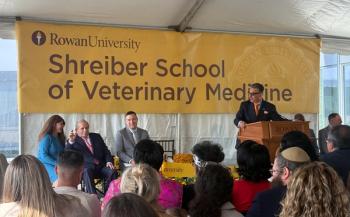
Hot-button veterinary topics from AVMA meeting
New Orleans - Whether even to discuss a ban on antimicrobials in livestock feed for growth promotion split the House of Delegates nearly in half at the annual American Veterinary Medical Association (AVMA) conference.
New Orleans — Whether even to discuss a ban on antimicrobials in livestock feed for growth promotion split the House of Delegates nearly in half at the annual American Veterinary Medical Association (AVMA) conference.
A slim majority wanted to discuss the issue, but that wasn't enough to put it to a vote.
Because the proposed resolution did not arrive in time, delegates had to decide whether the time requirement could be waived, thus placing the issue on the agenda. A two-thirds majority was needed, but the vote was well short of that — 50.2 percent to 49.8 percent in favor of discussion.
Still, conversations about the hot-button issue prevailed throughout the two-day House meetings.
Several people turned up at the Scientific Activities Committee session, hoping the issue would be discussed.
Dr. Gatz Ridell, executive vice president of the American Association of Bovine Practitioners, says there is really no good scientific evidence to support a ban.
"Once it goes into the animal, there is an approved wait time so it shouldn't get into the food supply," Ridell says.
Ridell is in favor of moving the AVMA policy forward on the issue by making sure veterinarians have more of a role in prescribing antibiotics. Both the bovine practitioners and the swine veterinarians submitted Resolution 18 to that effect, but it was withdrawn when Resolution 15 was not heard.
Riddell says the various groups that submitted Resolution 18 will continue to work through the AVMA system to get it approved.
Dr. Thomas Burkgren, executive director of the American Association of Swine Veterinarians, says before proposing an outright ban on antimicrobials, the AVMA has to consider the consequences.
One place where a ban has not seemed to work is Denmark, where antimicrobials are no longer used. Newborn and young pigs die more frequently there than in places where antibiotics are used. In addition, antibiotic-resistant MRSA remains prevalent.
"We have to look at the unintended consequences," Burkgren says. "This is just a knee-jerk action. Let's ban all of it. It doesn't involve me. I'm a dog-and-cat guy."
AVMA Animal Welfare Division Director Dr. Lyle Vogle dropped in when the conversation already was in full swing, saying Resolution 15 was flawed and mischaracterized current AVMA policy on the issue. He indicated the World Health Organization supports an antimicrobial ban and that MRSA is due to antimicrobials.
Although the issue did get a lot of talk in reference committee, New Jersey veterinarian Robert Gordon, whose state introduced the resolution, still wasn't pleased.
"I'm disturbed that the House of Delegates is unwilling even to discuss an issue that is not just AVMA important, but nationally and internationally important as well" says Gordon, who submitted the resolution after studying the issue while working on his master's degree in business administration.
"The AVMA is actively supporting the One Health Initiative issue and antimicrobials is part of that," he says.
"How can you be part of today's veterinary community and not even talk about it? We can't live in a vacuum. Public health is an ongoing issue. In 30 years, the change will have happened. If we want to continue doing things the way we have done for the past 30 years, we will not be leaders."
"People want antibiotic-free and we should be at the front of the class teaching everyone, saying here is our stance," Gordon says.
As it stands now, Gordon says veterinarians are "out of the loop" and that shouldn't be the case.
"We need to reinsert the veterinarian making the evaluation and strengthening veterinary input," he says.
Dr. Bernadette Dunham, director of the U.S. Food and Drug Administration Center for Veterinary Medicine, agrees, saying it comes down to semantics as far as the public is concerned.
"The public hears growth promotion and feed efficiency, but they don't hear disease control," Dunham says. "We as veterinarians lost control of antimicrobials with over-the-counter sales." What is key is getting that control back, educating the public about antimicrobials and having a discussion about the issue.
Dr. Michael Blackwell, of Blackwell Consulting and the only veterinarian on the PEW Commission, says people believe veterinarians should be doing more to protect the food supply.
"The general public trusts the veterinary profession more than Farmer Joe down the road, so it is the profession's responsibility to be the gatekeeper as far as antimicrobials in the food supply," he says.
Delegates OKresolution supporting room for movement in veal calves' housing
The American Veterinary Medical Association (AVMA) House of Delegates adopted a policy regarding veal calf housing that promotes animal health and welfare.
Resolution 16, accepted by 88.7 percent of the delegates, states that the AVMA supports a change from veal-husbandry systems that "severely restrict movement" to housing that allows "greater freedom of movement without compromising health or welfare."
AVMA Executive Vice President Dr. Ron DeHaven says the resolution seeks to improve the welfare of veal calves, while affording the AVMA Animal Welfare Division the opportunity to conduct "a comprehensive analysis of the science to consider all relevant perspectives of veal calf production."
If the issue of whether to discuss the use of antimicrobials was contentious, voting on a resolution to change veal-husbandry practices was equally so.
Resolution 14 called for the AVMA to support a change from the individual calf crate system to group housing systems that allow for freedom of movement and socialization.
Resolution 16 called for the AVMA to support a change in veal-husbandry practices that severely restrict movement to housing systems that allow for greater freedom of movement without compromising their health.
"How much longer are we going to be viewed as slow to act and not contemporary?" Massachusetts veterinarian John de Jong asked his peers.
He urged veterinarians to vote down Resolution 14 in favor of Resolution 16.
"We can leave here doing one of two things," de Jong said. "We can unnecessarily delay and refer it back to committee, potentially looking ineffectual, or we can proceed with action and still allow the Animal Welfare Division to study the issue."
Oregon veterinarian Dr. Martha DeWees opposed the issue, saying it should be a part of AVMA's overall animal-welfare policy and the House of Delegates shouldn't "micro-manage" every animal-housing issue.
"If we did, where would it stop?" she asked.
In the end, Resolution 14 was referred to the Animal Welfare Division by a vote of 64.3 percent to 35.7 percent.
Resolution 16 was amended to include "or welfare" at the end and was approved 88.7 percent to 31.3 percent.
Dr. Gail Golab, associate director of the Animal Welfare Division, started her examination of the issue last fall.
Newsletter
From exam room tips to practice management insights, get trusted veterinary news delivered straight to your inbox—subscribe to dvm360.




